With just five main ingredients and a selection of spices from your pantry, you can create a vibrant and flavorful homemade Marinara Sauce that will tantalize your taste buds! This go-to recipe for the classic Italian tomato sauce is perfect for pasta, pizza, or as a delightful dipping sauce.

About Marinara Sauce
Marinara is a tomato-based sauce that originated in Italy in the 1600s. While there are many variations of marinara around the world, the essential ingredients—tomatoes, onions, garlic, and oregano—remain constant.
This delicious tomato sauce is a staple in Italian cooking, often used for pasta and pizza in Italian-American cuisine.
Marinara translates to “mariner’s,” likely referring to the sailors who brought tomatoes to Italy from the Americas in the mid-17th century.
Although tomatoes are now a cornerstone of Italian cuisine, it’s fascinating to note that this wasn’t always the case.
Historical records suggest that the sauce was first crafted in Napoli, Italy. Outside the U.S., it is sometimes referred to as “Napoli Sauce” or “Neapolitan Sauce.”
Regardless of its name, I highly recommend making a generous batch of this beautiful red sauce as soon as you can.
Why This Recipe Works
Homemade sauces are so satisfying that I almost always prefer making them myself. This Marinara Sauce is no exception! Crafted from fresh, wholesome ingredients without fillers, additives, or preservatives, this recipe is simply perfect.
What I love about this marinara recipe is its adaptability. You can use fresh or canned tomatoes, and dried or fresh herbs, depending on what you have available. Since many of the ingredients are pantry staples, it makes for an excellent last-minute meal!
While it takes a little time, caramelizing the onions adds a distinct sweetness to this marinara. Slow cooking the sauce enhances the flavors of the tomatoes, resulting in a thick, aromatic, and flavorful sauce.
This delicious sauce can serve as a base for pizzas, be spooned over pasta, or used as a dipping sauce for grilled cheese sandwiches or fried mozzarella sticks.
Moreover, due to the high acidity of tomatoes, this marinara is a fantastic candidate for water-bath canning. Prepare a large batch to store in the fridge for those days when you’re unsure what to cook, or gift some to friends and family during the holidays!
This straightforward recipe is one you’ll return to time and again. It has become one of our absolute favorite sauces, and I’m confident it will become one of yours too.
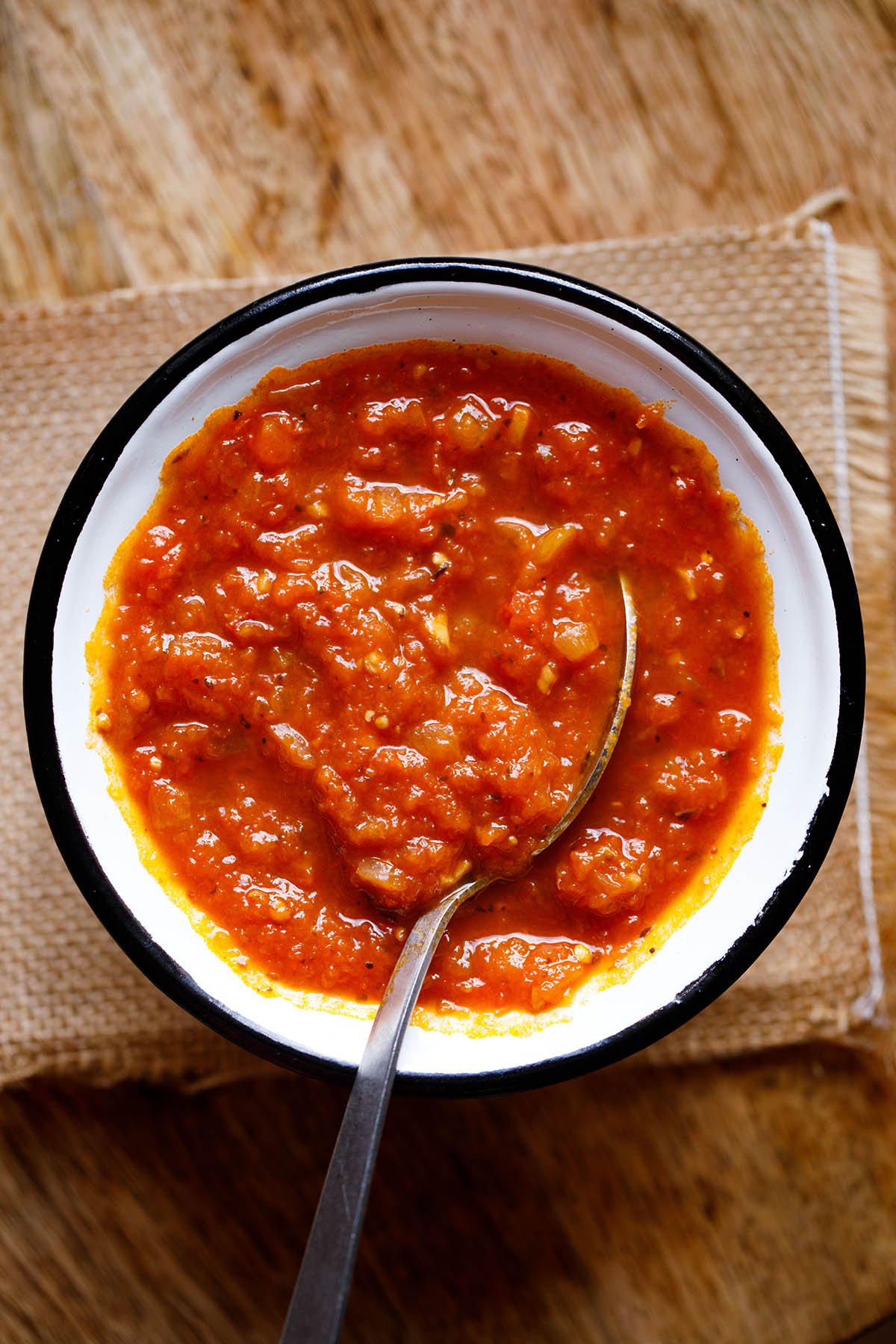
What Do You Use Marinara Sauce For?
Marinara sauce is the quintessential Italian tomato sauce for a good reason. It is incredibly versatile and can be used in a variety of dishes. Here are some ideas:
- Serve it over your favorite pasta or layer it into lasagna.
- Use it as the base for Eggplant Parmesan.
- Spread it over pizza dough and top with your favorite cheese and vegetables before baking. Alternatively, make a personal-sized pizza using naan as your base!
- It makes a fantastic dip for appetizers like fried ravioli, cheese sticks, or breadsticks. It’s also great for dipping sandwiches!
- Add it to soups for a savory tomato flavor, or mix in a touch of cream to create a creamy tomato soup!
However you choose to use this delicious red sauce, I have a feeling you’re going to love it.
How to Make Marinara Sauce
Blend Fresh Tomatoes
1. Rinse, drain, and chop 1 kilogram of tomatoes. Place the tomatoes in a blender.

2. Blend the tomatoes but do not create a smooth puree. The consistency should be slightly chunky, resembling a semi-coarse or semi-fine puree.

Sauté Aromatics
3. Heat 3 tablespoons of extra virgin olive oil in a pan or pot.

4. Add 1 cup of finely chopped onion and 2 tablespoons of finely chopped garlic.

5. Mix and sauté the onions and garlic over low to medium-low heat.
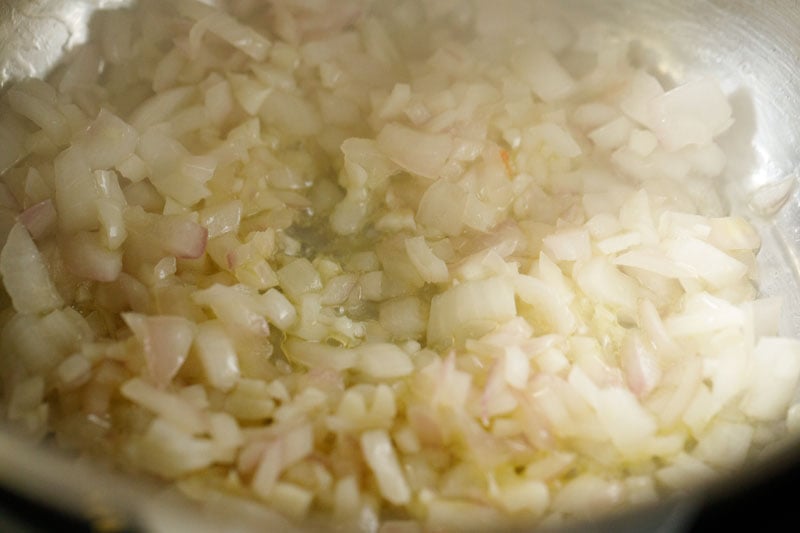
6. Sauté until the onions caramelize, stirring often.
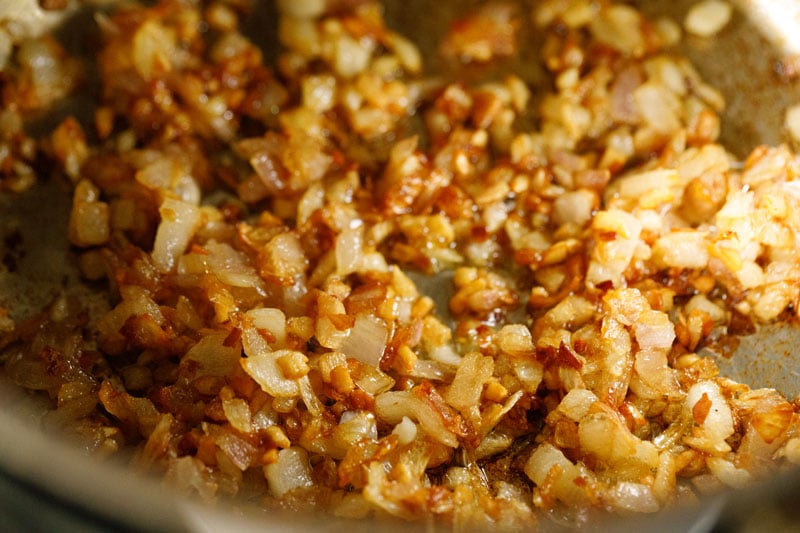
Deglaze With Wine
7. Add ¼ cup of red or white wine to deglaze the pan, scraping up any browned bits stuck to the bottom!
Wine adds a wonderful flavor to the sauce. If you prefer not to use wine, feel free to skip this step and proceed to step 9.
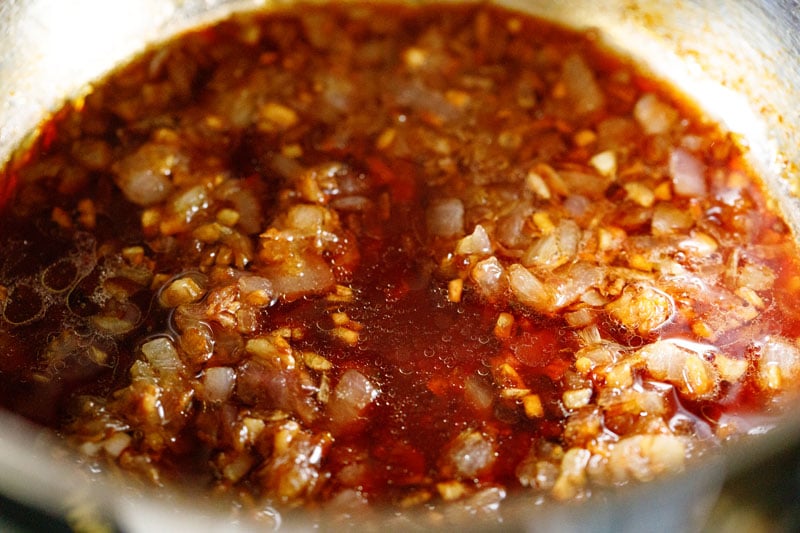
8. Simmer until the wine evaporates.
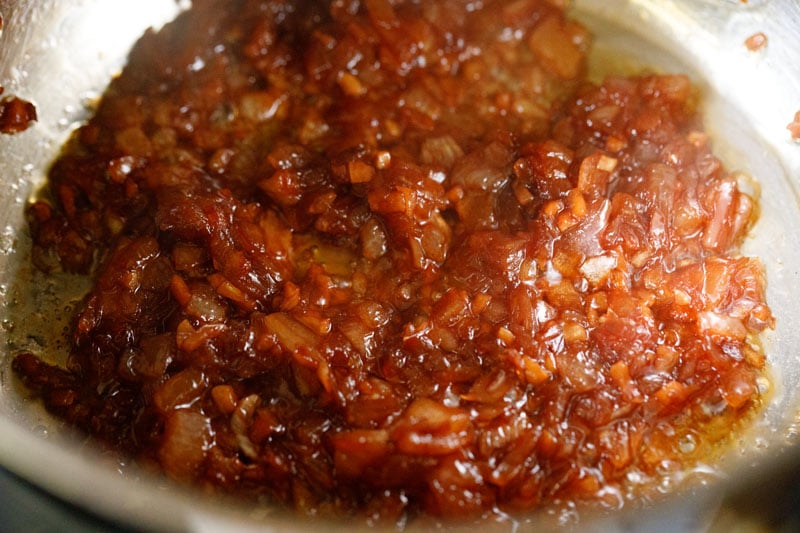
Add Tomato Puree
9. Add the chunky tomato puree.
Tip: If using canned whole peeled tomatoes, crush them first before adding. You may also find canned crushed tomatoes depending on your location.
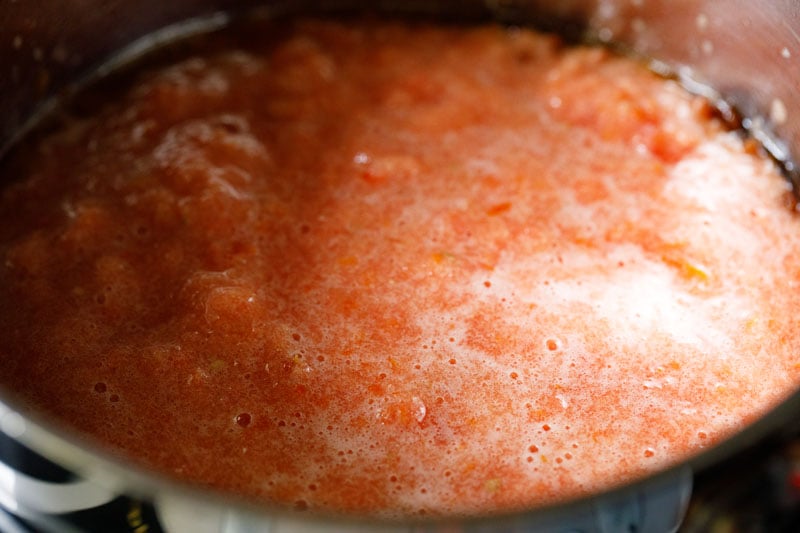
10. Season with the following spices and herbs:
- 1 teaspoon dried basil (or 2 to 3 tablespoons fresh chopped basil)
- ½ teaspoon dried oregano (or 1 to 1.5 tablespoons fresh chopped oregano)
- ½ teaspoon red chili flakes (red pepper flakes)
- ½ teaspoon sea salt (or to taste; kosher salt or pink salt can also be used)
- ¼ teaspoon freshly crushed black pepper

11. Add 1 cup of water and mix thoroughly.
Tip: For whole peeled tomatoes with juice, you do not need to add any water. For canned tomatoes, add about ⅓ to ½ cup of water.

12. Cover the pan.
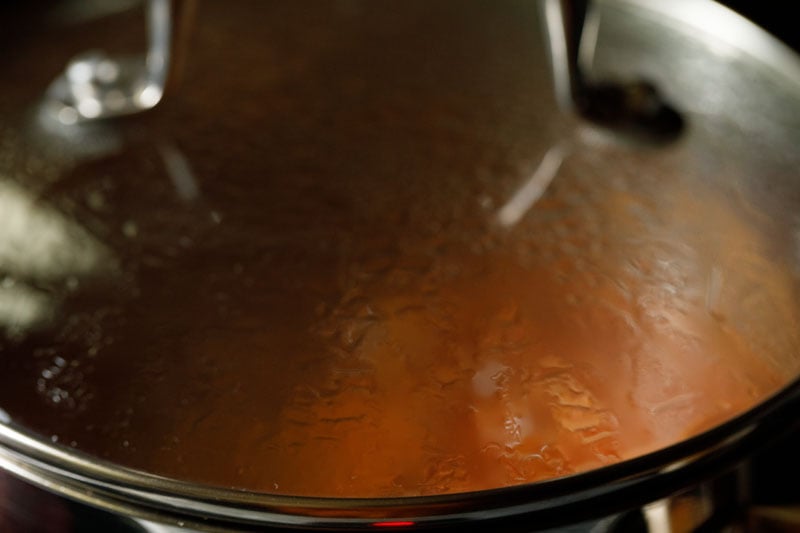
Make Marinara Sauce
13. Simmer for 40 to 45 minutes over low to medium-low heat, stirring and checking occasionally.
Tip: If using canned and peeled whole San Marzano tomatoes with juice, the simmering time may be shorter. Keep an eye on it and remove from heat when you reach the desired consistency.

14. Check occasionally as the sauce cooks.
Tip: If the sauce becomes too thick while simmering, you can always add some water.
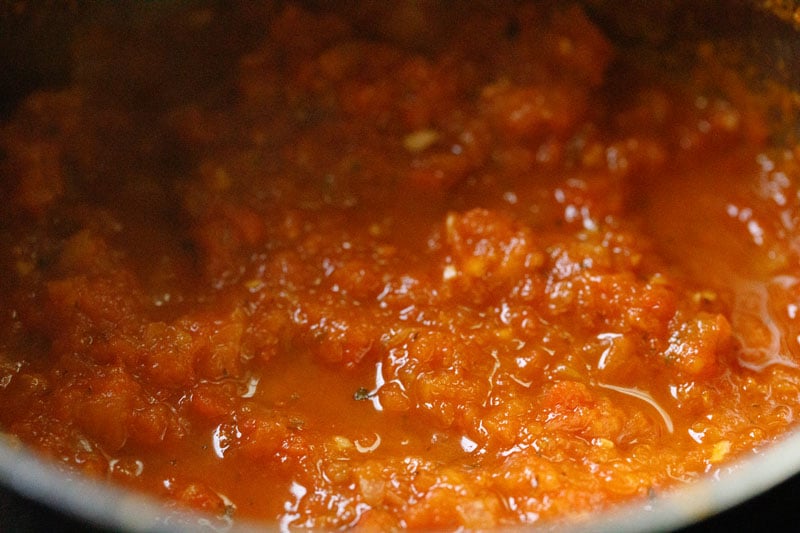
15. When the sauce has thickened to a flowing, medium-thick consistency, turn off the heat.

16. Finally, add 1 teaspoon of raw sugar or adjust to taste to balance the acidity of the marinara.
You can also use regular white granulated sugar, adjusting according to your taste.
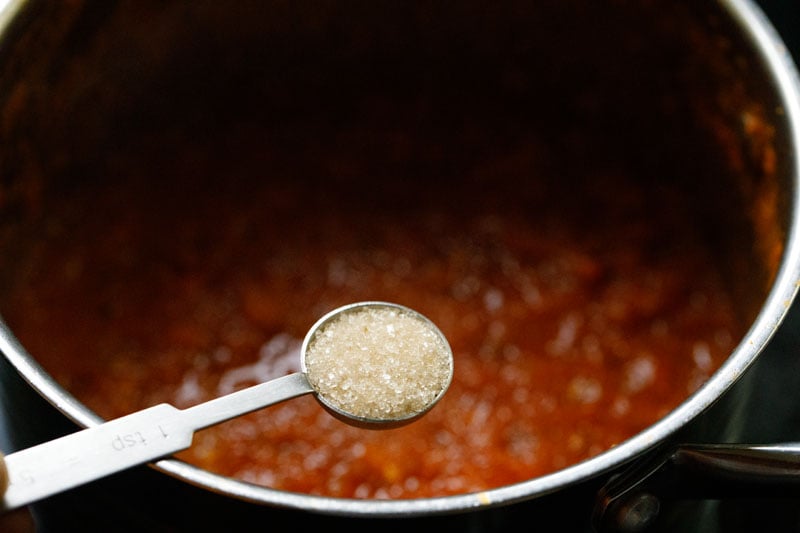
17. Mix well and simmer for another minute. Taste the sauce and add more salt or herbs if needed.

Storing Suggestions
18. Spoon the marinara sauce into clean or sterilized glass jars. Once cooled to room temperature, refrigerate.
The sauce will remain good for about 10 days in the refrigerator and up to 3 months in the freezer.
I often freeze some of the sauce to have on hand for busy nights when I’m too tired to cook dinner.

Expert Tips
This marinara sauce recipe is quite simple. However, if you need some troubleshooting, check out the tips below:
- Herbs: Fresh herbs like basil or oregano can replace dried ones. Use approximately 1 tablespoon of fresh herbs for every teaspoon of dried herbs you wish to substitute. Celery can also be added if desired.
- Add More Umami: For a richer sauce, consider adding up to ¼ cup of tomato paste. I recommend adding it to the sautéed onions and garlic before deglazing the pan, as cooking the tomato paste enhances the flavor.
- Tomatoes: When using fresh tomatoes, choose ripe, red, and sweet ones. Avoid unripe or tart varieties. Any fresh tomato variety is suitable, including Roma, beefsteak, Cherokee Purple, Brandywine, or Early Girl tomatoes.
- Canned Tomatoes: Canned whole peeled tomatoes in their juice are my first choice. You can also save time by using canned crushed tomatoes.
More Tips
- If the sauce tastes too tart, balance it by adding a bit of sugar.
- I use red wine in the recipe. Deglazing with red wine adds a layer of flavor to the sauce, and all the alcohol will evaporate before serving. However, you can omit it, and the sauce will still taste great. If you only cook with wine, consider purchasing boxed wine, which lasts longer since it doesn’t get exposed to air.
- For the best results, take your time! Caramelizing the onions adds depth of flavor and sweetness to the sauce. Slow cooking and reducing the sauce allows all the flavors of the fresh tomatoes to meld, resulting in a thick, aromatic, and flavorful sauce.
FAQs
Pizza sauce is typically thicker and more concentrated than marinara, although the ingredients are quite similar. You can find a homemade pizza sauce recipe below, or simply use this marinara recipe instead!
It sounds like you may have rushed the cooking process. I recommend simmering it a bit longer with the lid off to allow excess moisture to evaporate.
Absolutely! It may be a bit thinner than what you’re used to for pizza sauce, but simmering it for a few minutes can help thicken it and evaporate excess water.
More Questions Answered
Is marinara sauce healthy?
Yes! Marinara is rich in the nutrients found in tomatoes, onions, and garlic. It is high in vitamin C, making it a great choice for boosting your immune system. Additionally, it contains lycopene, an antioxidant linked to cancer prevention.
Is marinara the same as tomato sauce?
Marinara is a tomato-based sauce that also includes other ingredients like onions, garlic, herbs, and spices. Store-bought tomato sauce typically contains only tomatoes.
What is the difference between marinara sauce and spaghetti sauce?
These terms are often used interchangeably. However, “spaghetti sauce” may include additional vegetables and even mushrooms, while marinara sauce is always made with tomatoes, onions, garlic, and herbs.




